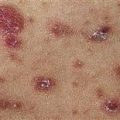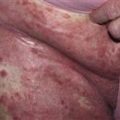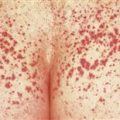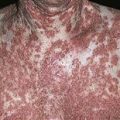81
Tinea of the beard

Ringworm infection pattern. Annular border covers a wide area of cheek. Little inflammation in central area of plaque. Specimens for potassium hydroxide examination are best taken from the border.
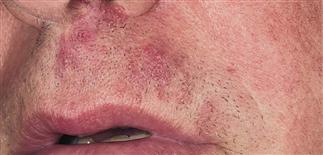
Red papules were present for weeks. There was some itching. A diagnosis of seborrheic dermatitis was incorrectly made. Topical steroids were ineffective.
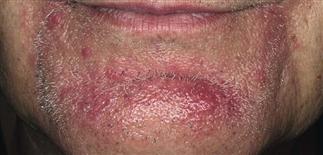
Inflammation of the chin spread slowly for weeks. A potassium hydroxide examination was positive for fungal hyphae.
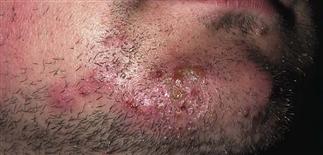
Bacterial folliculitis was the initial diagnosis, but the pustular eruption failed to respond to several different antibiotics. Hair were easily extracted and showed numerous fungal hyphae.
DESCRIPTION
Fungal infections of the beard often misdiagnosed as bacterial folliculitis. Diagnosis is then suspected only when multiple courses of antibiotics are ineffective.
HISTORY
• Tinea is a slowly evolving disease, in contrast to bacterial infections. • Infections often subtle with little or no itching. • Deep infection of the follicle causes pain and swelling. • Wrestlers and farmers in contact with cows are at risk.
PHYSICAL FINDINGS
• Ringworm pattern. Lesions similar to the round plaques found on body. Border is scaling and sharply defined. Plaques may reach considerable size before they are recognized. The hair follicles within the plaque may also be infected. • Follicular pattern. Deep follicular infection causes erythema, papules, and pustules that resemble bacterial folliculitis. The fungal infection smolders and slowly spreads. Oral antibiotics may provide some relief by treating a secondary bacterial infection. Pustules and draining nodules may lead to kerion formation and permanent scarring. Regional lymphadenopathy may occur.
Obtain hair for examination and culture. Hairs infected with fungi are easily and painlessly epilated. Hairs in an area of bacterial folliculitis are extracted with difficulty. Fungal cultures are required if the diagnosis is suspected but cannot be confirmed by potassium hydroxide examination. A positive culture for Staphylococcus does not rule out tinea. The positive culture may represent a secondary bacterial infection.
TREATMENT
• Topical antifungal agents are not reliably effective, because they do not penetrate deep enough into the hair follicle. • Adult men are treated with terbinafine (Lamisil) 250 mg q.d. for 2–4 weeks, itraconazole (Sporanox) 200 mg q.d. for 2–4 weeks, fluconazole (Diflucan) 150 mg once a week for 3–4 weeks, or ultramicrosize griseofulvin 250 mg or 330 mg b.i.d. for 4 weeks.


